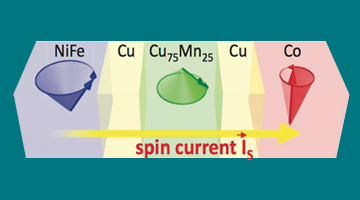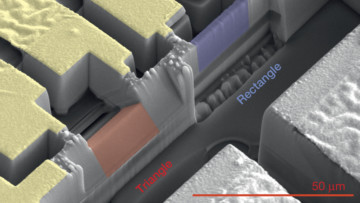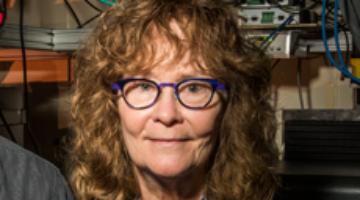Researchers predicted and observed for the first time the formation and growth of furans and other oxygenated hydrocarbons produced during combustion. These compounds can have a wide range of detrimental effects on human health, air quality, and regional and global climate. Read more »
How to Directly Probe ac Spin Currents
Scientists working at the ALS have made the first unambiguous, direct measurements of ac spin currents flowing through nanostructured metal layers. The work represents a crucial step toward the development of future spintronic devices that are smaller, faster, and more energy efficient. Read more »![]()
![]()
ALS Spectrum
Begun in 2007, ALS Spectrum is a publication that encapsulates the same type of information contained in the ALS Activity Report but in a short, readable, newsletter-like format. Featured scientific and facility developments are front-paged, and a roundup of science highlights is provided in easily browsable summaries with Web links. Contents also include brief reportsRead More Read more »
Scientists Find Twisting 3-D Raceway for Electrons in Nanoscale Crystal Slices
Researchers have observed, for the first time, an exotic 3-D racetrack for electrons in ultrathin slices of a tiny crystal they made at Berkeley Lab. Read more »
A Conscious Coupling of Magnetic and Electric Materials
Scientists have successfully paired ferroelectric and ferrimagnetic materials so that their alignment can be controlled with a small electric field at near room temperatures, an achievement that could open doors to ultralow-power microprocessors, storage devices and next-generation electronics. Read more »
ALS in the News (Sep 2016)
- Teams of Scientists Gather at Berkeley Lab to Study Secrets of Plants’ Plumbing
- Berkeley Lab Hosts UK Scientific Technology Facilities Council
- Researchers Peel Back Another Layer of Chemistry with ‘Tender’ X-rays
- Calcium channel blockers caught in the act at atomic level
- A New Way to Display the 3-D Structure of Molecules
- 2016 R&D 100 Awards – Berkeley Lab Finalists
- Fadley is Honorary Member of International Scientific Committee
- Energy Department to Invest $16 Million in Computer Design of Materials
ALS Users’ Executive Committee Update
The ALS UEC met last week to discuss the upcoming User Meeting, solicitation of new UEC members, and the pending update for the ALS UEC website. Read more »
Molecular Switch Triggers Bacterial Pathogenicity
Using an array of high-powered x-ray imaging techniques at the ALS, scientists have revealed for the first time the molecular steps that turn on bacteria’s pathogenic genes. The study could open up new avenues in the development of drugs to prevent or treat bacterial infection. Read more »![]()
![]()
Reminder: Early Registration for 2016 ALS User Meeting Ends Sept. 19
Discounted early registration ends Monday, September 19, for the 2016 ALS User Meeting, which will take place October 3-5. To register, view the draft agenda and logistical information, and learn how to nominate colleagues for scientific, technical, and user support awards, visit the User Meeting webpage. Read more »
ALS Brightness Improvement Team wins DOE Achievement Award
Members of the ALS Brightness Improvement Team have been recognized by the Department of Energy with a prestigious Secretary of Energy Achievement Award. This distinction follows the team’s receipt last December of a Berkeley Lab Director’s Award for Exceptional Scientific Achievement. Read more »
- « Previous Page
- 1
- …
- 72
- 73
- 74
- 75
- 76
- …
- 83
- Next Page »







